#scottish baronial
Text




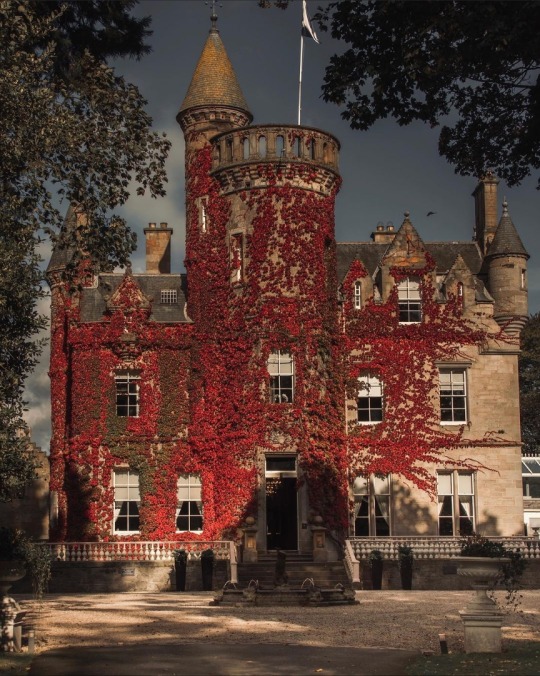
Carlowrie Castle, Kirkliston, Scotland
(snapsbyshirin)
#gothic#gothic architecture#scottish baronial#gothic castle#renaissance#neo gothic#gothic revival#carlowrie castle#kirkliston#edinburgh#lothian#scotland#britain#great britain#fall#autumn
41 notes
·
View notes
Text
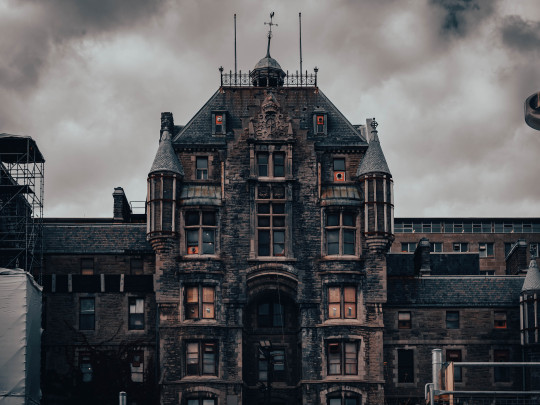
#halloween#scottish baronial#architecture#spookycre#spooky aesthetic#creepy#decay#historic architecture#montreal#montréal#mtl#photography
12 notes
·
View notes
Text

Today's photo with the most hits: the Earl's Palace, Kirkwall, Orkney.
1 note
·
View note
Text

Scottish baronial architecture reached its zenith with Castle Fraser
#Castle Fraser#Inverurie#Aberdeenshire#River Dee#UK#Scottish castles#baronial architecture#mediaeval#turrets
72 notes
·
View notes
Text

Ardverikie Castle in winter
#Ardverikie House#19th-century#Scottish baronial house#Monarch of the Glen#Ardverikie Castle in winter#winter#snow#goth aesthetic#medieval#gothic aesthetic#baronial
171 notes
·
View notes
Text
PEARSE STREET GARDA STATION
Police barracks built for the Dublin Metropolitan Police, replacing the former barracks on College Street. Commissioned in 1910, it was built to designs by the Office of Public Works under the supervision of M.J. Burke
POLICE STATION
Police barracks built for the Dublin Metropolitan Police, replacing the former barracks on College Street. Commissioned in 1910, it was built to designs by the Office of Public Works under the supervision of M.J. Burke, with H.G. Leask and A. Robinson as job architects. Built in a Scottish Baronial style, evident in the gables and mullioned windows. The bow end to College and…

View On WordPress
#An Garda Síochána#DP3#Dublin Metropolitan Police#Fotonique#Infomatique#pearse street#Police barracks#Police Station#Quattro#Scottish Baronial style#sigma#William Murphy
0 notes
Photo

@joslyncastle #omaha #landmark in 1979 The #castle was added to the #national #register of #historic #places in 1972. Built in #scottish #baronial style #mansion #nebraska #usa #educational #historical #travel #traveling #travelling (at Joslyn Castle) https://www.instagram.com/p/CfLCYfGMlge/?igshid=NGJjMDIxMWI=
#omaha#landmark#castle#national#register#historic#places#scottish#baronial#mansion#nebraska#usa#educational#historical#travel#traveling#travelling
0 notes
Text
Inside William’s Next Act: Tatler’s May issue goes behind the scenes as the Prince of Wales is rising above the noise — and playing the long game
The burden of leadership is falling upon Prince William, but as former BBC Royal Correspondent, Wesley Kerr OBE, explains in Tatler’s May cover story, the future king is taking charge
By Wesley Kerr OBE
21 March 2024

When I first met Prince William in 2009, he asked me if I could tell him how he could win the National Lottery.
It was a jokey quip from someone who has since become the Prince of Wales, the holder of three dukedoms, three earldoms, two baronies and two knighthoods, and heir to the most prestigious throne on earth.
He was, of course, being relatable; I was representing the organisation that had allocated Lottery funding towards the Whitechapel Gallery and he wanted to put me at ease.
William is grand but different, royal but real.
At 6ft 3in, he has the bearing and looks great in uniform after a distinguished, gallant military career.
He will be one of the tallest of Britain’s kings since Edward Longshanks in the 14th century and should one day be crowned sitting above the Stone of Scone that Edward ‘borrowed.’
William, by contrast, has a deep affinity with Scotland and Wales, having lived in both nations and gained solace from the Scottish landscape after his mother died.
He’s popular in America and understands that the Crown’s relationship to the Commonwealth must evolve.
The Prince of Wales has long believed that ‘the Royal Family has to modernise and develop as it goes along, and it has to stay relevant’, as he once said in an interview.
He seeks his own way of being relatable, of benefitting everybody, in the context of an ancient institution undergoing significant challenge and upheaval, as the head of a nation divided by hard times, conflicts abroad, and social and political uncertainty.
We might recognise Shakespeare’s powerful line spoken by Claudius in Hamlet: ‘When sorrows come, they come not single spies, but in battalions.’
With the triple announcement in January and February of the Princess of Wales’s abdominal surgery and long convalescence, of King Charles’s prostate procedure and then of his cancer diagnosis, the burden of leadership has fallen on 76-year-old Queen Camilla and, crucially, on William.

The Prince of Wales’s time has come to step up; and so he has deftly done.
In recent months, we have seen a fully-fledged deputy head of state putting into practice his long-held ideas, speaking out on the most contentious issue of the day and taking direct action on homelessness.
Last June, he unveiled the multi-agency Homewards initiative with the huge aspiration of ending homelessness, backed with £3 million from his Foundation to spearhead action across the UK.
He is consolidating Heads Together, the long-standing campaign on mental health, and fundraises for charities like London’s Air Ambulance Charity.
He was, of course, once a pilot for the East Anglian Air Ambulance services – a profession that had its downside: seeing people in extremis or at death’s door, he found himself ‘taking home people’s trauma, people’s sadness.’
Tom Cruise was a guest at the recent London’s Air Ambulance Charity fundraiser, William’s first gala event after Kate’s operation.
And more stardust followed when William showed that, even without his wife by his side, he could outclass any movie star at the Baftas.
There’s also his immense aim of helping to ‘repair the planet’ itself with his Earthshot Prize: five annual awards of £1 million for transformative environmental projects with worldwide application.
This project has a laser focus on biodiversity, better air quality, cleaner seas, reducing waste and combating climate change. Similar aims to his father; different means to achieve the goal.
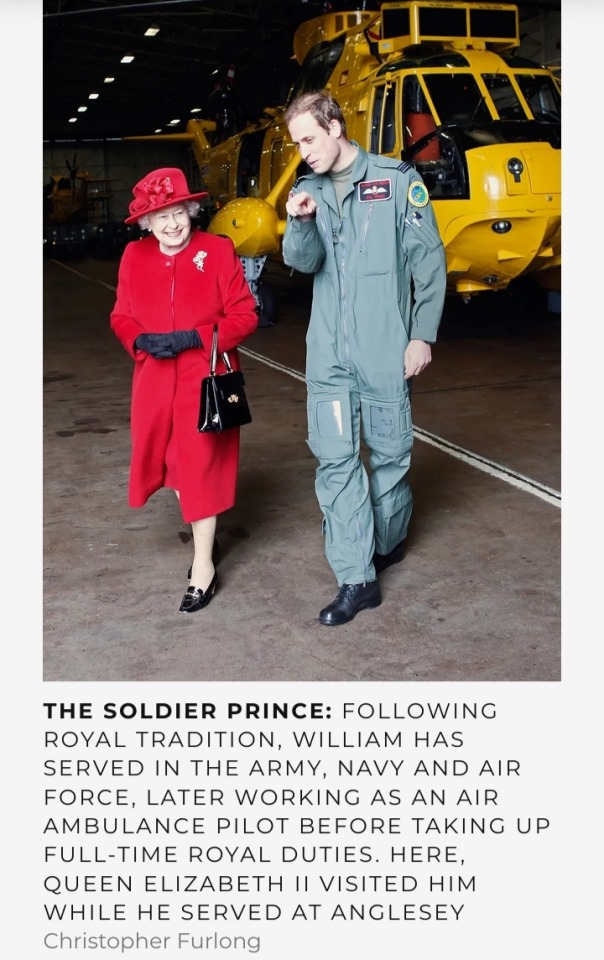
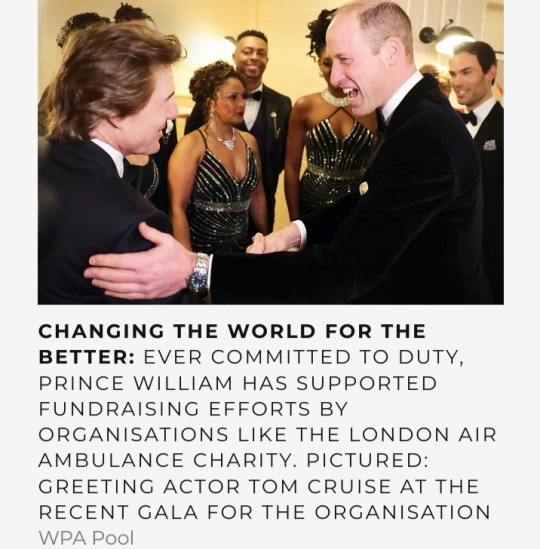
On the issue which has caused huge convulsions – the Middle East conflict – William’s 20 February statement from Kensington Palace grabbed attention.
He said he was ‘deeply concerned about the terrible human cost of the conflict since the Hamas terrorist attack on 7 October. Too many have been killed.’
There were criticisms – along the lines of ‘the late Queen would have never spoken out like this’ or ‘what right does he have to meddle in politics?’ – but it was hard to disagree with his carefully calibrated words.
His call for peace, the ‘desperate need’ for humanitarian aid, the return of the hostages.
The statement was approved by His Majesty’s Government, likely cleared with the King himself at Sandringham the previous weekend and also backed by the chief rabbi of Great Britain, Sir Ephraim Mirvis.
Indeed, William and Catherine had immediately spoken out on the horrors of 7 October.
William followed up the week after his Kensington Palace statement by visiting a synagogue and sending a ‘powerful message’, according to the chief rabbi, by meeting a Holocaust survivor and condemning anti-Semitism.
This is rooted in deep personal conviction following William’s 2018 visit to Israel and the West Bank, says Valentine Low, the distinguished author of Courtiers and The Times’s royal correspondent of 15 years, who was on that 2018 trip.
‘William was so moved by his visit to Israel and the West Bank, he found it very affecting, and he was not going to drop this issue – he was going to pay attention to it for the rest of his life,’ says Low.
‘He must feel that… not to say something on the most important issue in the world [at that moment] would be a bit odd if you feel so strongly about it.’
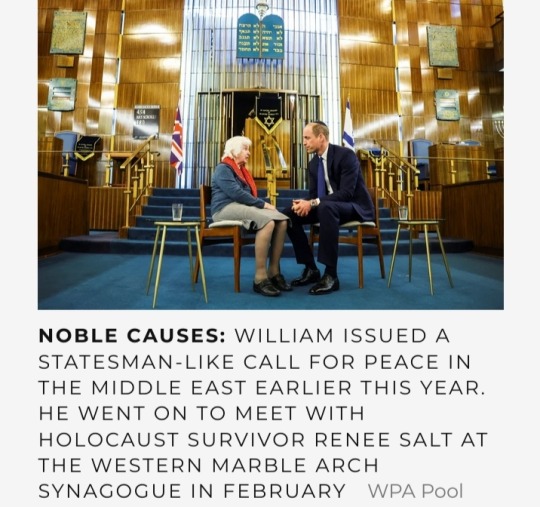
There was concern from some commentators about politicising the monarchy, but this rose above the particulars of party politics.
As Prince of Wales, like his father before him, there is perhaps space to speak out sparingly on carefully chosen issues.
On this occasion, his views were in line with majority public opinion.
On homelessness, news came that same week that William was planning to build 24 homes for the homeless on his Duchy of Cornwall estate.
‘William’s impact is very personal,’ says Mick Clarke, chief executive of The Passage, a charity providing emergency accommodation for London’s homeless.
‘Two weeks before Christmas, the prince came to our Resource Centre in Victoria for a Christmas lunch for 150 people.
He was scheduled to stay for an hour, to help serve, wash up, and talk to people.
He ended up staying for two and a quarter hours, during which time he went from table to table and spoke to every single person.’
Clarke continues:
‘William has an ability to listen, talk and to put people at ease. During the November 2020 lockdown, he came on three separate occasions to help.
It gave the team a boost that he took the time; it was his way of saying: “I support you; you’re doing a great job.”’
Seyi Obakin, chief executive of Centrepoint, one of the prince’s best-known causes, adds:
‘People associate his patronage with the big moments like the time he and I slept under Blackfriars Bridge.
The things that stick with me are smaller in scale and the more profound for it – in quieter moments, away from the cameras, where he has volunteered his time.’
It is a different approach from the King’s.
As Prince of Wales, he was involved in the minutiae of dozens of issues at any one time, working into the night to follow up on emails, crafting his speeches, writing or dictating notes.
Add to that much nationwide touring over 40 years (after he left active military service in 1976), fitting in multiple engagements, often being greeted formally by lord lieutenants.
This is not William’s style. He has commended his father’s model, but he does things his own way.
Although patronages are under review, William has up till now far fewer than either his father or his grandparents.
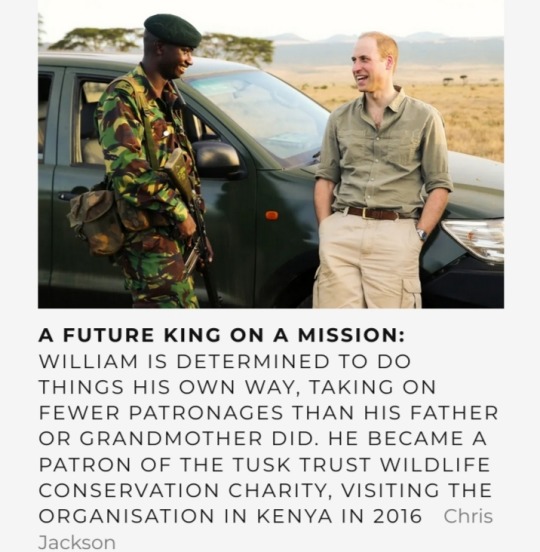
Charles is sympathetic to William’s approach and his desire to make time with his young family sacrosanct.
They are confidantes, attested by the night of Queen Elizabeth’s death.
They were both at Birkhall with Camilla, reviewing funeral arrangements while the rest of the grieving family were nearby at Balmoral, hosted by the Princess Royal.
Charles has had almost six decades in public life and is the senior statesman of our time, with even longer in the spotlight than Joe Biden.
After Eton and St Andrew’s University, where he met Catherine, William served in three branches of the military between 2006 and 2013, finishing as a seasoned and skilled helicopter rescue pilot.
His later employment as an air ambulance pilot stopped in 2017, when he became a full-time working royal.
At that time, not so long ago – with Harry unmarried, Andrew undisgraced, and Philip and Elizabeth still active – William shared the spotlight.
Now, after the King, he’s the key man.
He can look back on the success of his first big campaign initially launched with his wife and brother in 2016: Heads Together.
‘We are delighted that Prince William should have become such a positive and sympathetic advocate for mental health through his Heads Together initiative and now well-established text service, Shout, among other projects,’ says the longtime CEO and founder of Sane, the remarkable Marjorie Wallace CBE.
‘It is not always known that he follows in the footsteps of his father, the King, whose inspiration and vision were vital in the creation of our mental health charity Sane.
As founding patron, he was instrumental in establishing our 365-days-a-year helpline and was a remarkable and selfless support to me in setting up the Prince of Wales International Centre for Sane Research.’
'Indeed,' says Wallace, 'this is where Prince William echoes the work of his father, showing the same ‘understanding and compassion for people struggling through dark and difficult times of their lives and has done much to raise awareness and encourage those affected to speak out and seek help.
We owe a huge debt to His Majesty and the Prince of Wales for their involvement in this still-neglected area.’
Just as I saw all those years ago at that early solo engagement in Whitechapel, William still approaches his public duties with humour and fun.
‘He defuses the formality with jocularity,’ says Valentine Low, citing two public events in 2023 that he witnessed.
In April last year, while on a visit to Birmingham, William randomly answered the phone in an Indian restaurant he was being shown around and took a table booking from a customer – an endearing act of spontaneity.
On his arrival later that day, the unsuspecting diner was surprised to be told exactly whom he had been talking to.

In October, Low reported, William ‘unleashed his inner flirt as he hugged his way through a visit with Caribbean elders [in Cardiff] to mark Black History Month.
As he gave one woman a hug – for longer than she expected – he joked: “I draw the line at kissing.”
And while posing for a group photograph, he prompted gales of laughter when he quipped: “Who is pinching my bottom?”’
Low believes that when William eventually becomes king, he will be more ‘radical’ than his father but wonders if people will respond to ‘call me William’ when ‘the whole point of the Royal Family is mystique and being different.’
However, William has thought deeply about his current role and is prepared for whatever his future holds.
For now, there is a decision to be made on Prince George’s secondary schooling. It’s said that five public schools are being considered, all fee-paying.
Eton is single-sex and boarding but close to home. Marlborough (Catherine’s alma mater) is co-ed and full boarding. And Oundle, St Edward’s Oxford and Bradfield College (close to Kate’s parents) are co-ed with a mix of boarding and day.
As parents, William and Catherine aspire to raise their children ‘as good people with the idea of service and duty to others as very important’, William said in an interview with the BBC in 2016.
‘Within our family unit, we are a normal family.’ Which may be one reason why he is so resistant to their privacy being compromised either by the media or close family members.
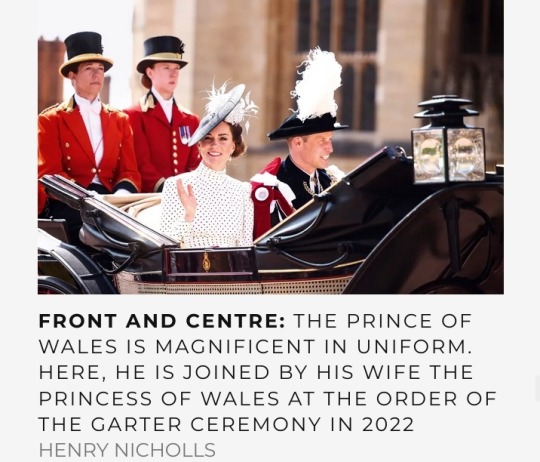
The 19th-century author Walter Bagehot wrote:
‘A family on the throne is an interesting idea also. It brings down the pride of sovereignty to the level of petty life… a princely marriage is the brilliant edition of a universal fact, and, as such, it rivets mankind.’
If hereditary monarchy is to survive, it must beguile us but also demonstrate its utility, that it is a force for good.
William said in that 2016 interview, ‘I’m going to get plenty of criticism over my lifetime,’ echoing Queen Elizabeth II’s famous Guildhall speech in 1992 ‘that criticism is good for people and institutions that are part of public life. No institution – city, monarchy, whatever – should expect to be free from the scrutiny of those who give it their loyalty and support, not to mention those who don’t.’
William saw close up his mother’s ability to bring public focus and her own personal magnetism to any subject or cause she focused on.
He admires his father’s work ethic, the way he ‘really digs down,’ sometimes literally (I understand that gardening is giving the King solace during his cancer treatment).
But the biggest influence for William was Her late Majesty, as he said on her 90th birthday.
As an Eton schoolboy, William made weekend visits to the big house on the hill, being mentored by Granny rather as she had been tutored in the Second World War by the then vice-provost of Eton, Sir Henry Marten.
William said in 2016:
‘In the Queen, I have an extraordinary example of somebody who’s done an enormous amount of good and she’s probably the best role model I could have.’
That said, his aim was ‘finding your own path but with very good examples and guidance around you to support you.'

Queen Elizabeth II had a brilliant way of rising above the fray and usually being either a step ahead of public opinion or in tune with it.
If you are at the helm of affairs in a privileged hereditary position, your duty is to serve and use your pulpit for the benefit of others.
In a democracy, monarchy is accountable.
The scrutiny is intense, with an army of commentators paid for wisdom and hot air about each no-show, parsing each announcement, interpreting each image.
William takes the long view. He has ‘wide horizons,’ says Mick Clarke.
‘There are so many causes that are more palatable and easier to achieve than ending homelessness, but his commitment and drive are 100 per cent.’
The prince seeks a different way of being royal in an ancient institution that must move with the times. His task? To develop something modern in an ever-changing world.
He faces all sorts of new issues – or old issues in new guises.
Noises off from within the family don’t help – Andrew’s difficulties, or the suggestions of prejudice from Montecito a couple of years ago (now seemingly withdrawn), which prompted William’s most vehement soundbite: ‘We’re very much not a racist family.’
William is maybe a new kind of leader who can keep the monarchy relevant and resonant in the coming decades.
Queen Elizabeth II is a powerful exemplar and memory, but she was of her time. William is his own man.
He must overcome and think beyond ‘the unforgiving minute.’
Indeed, he could seek inspiration in Rudyard Kipling’s poem, If.
If you can force your heart and nerve and sinew
To serve your turn long after they are gone,
And so hold on when there is nothing in you
Except the Will which says to them: ‘Hold on!’
If you can talk with crowds and keep your virtue,
Or walk with Kings—nor lose the common touch[…]
Yours is the Earth and everything that’s in it,
And—which is more—you’ll be a Man, my son!
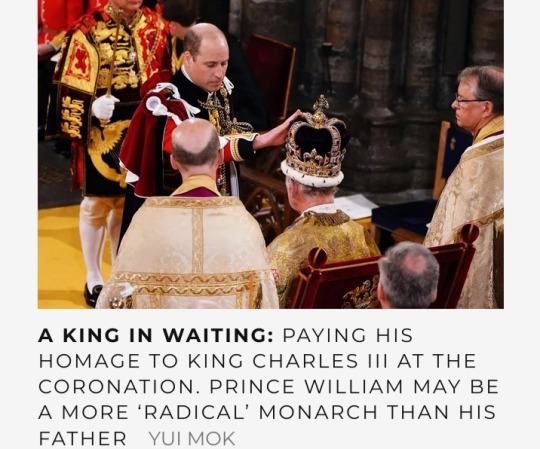
This article was first published in the May 2024 issue, on sale Thursday, 28 March.
#Prince William#Prince of Wales#British Royal Family#Wesley Kerr OBE#Edward Longshanks#Homewards#Heads Together#London’s Air Ambulance Charity#East Anglian Air Ambulance#Tom Cruise#BAFTAS#Earthshot Prize#Kensington Palace#King Charles III#Sir Ephraim Mirvis#Valentine Low#Duchy of Cornwall estate#The Passage#Centrepoint#Birkhall#Sane#Marjorie Wallace CBE#Shout#Balmoral#Prince George#Walter Bagehot#Sir Henry Marten#Rudyard Kipling#If
146 notes
·
View notes
Text

DID YOU KNOW: The Great Polish Map of Scotland is a large (50 m x 40 m) three-dimensional, outdoor concrete scale model of Scotland, located in the grounds of the Barony Castle Hotel, outside the village of Eddleston near Peebles in the Scottish Borders. It is also known as the Mapa Scotland (derived from Polish mapa Szkocji) or the Barony Map. The brainchild of Polish war veteran Jan Tomasik, it was built between 1974 and 1979 and is claimed to be the world's largest terrain relief model.The sculpture is a category B listed building,and has been restored by a group calling itself Mapa Scotland.
"A gift to the Scottish people for the hospitality the Scots had shown the Poles during the war years." - Jan Tomasik.
24 notes
·
View notes
Note
Personally, I've had enough of this circus. The monarchy does nothing to stop them and we end up wondering if there is not a double game on the part of Charles and the palace. Four years have passed and so many things that could have been done and nothing happened. The palace protects these two traitors and considers the public stupid. They could have taken away the duchy from them, demoted them to the rank of count and countess or worse, baron and baroness. All traitors.
Hi Nonny,
I think many people are feeing fed up with the Harkle antics and the lack of a firm response from the palace. I know I am. I agree that more could be done to minimise the Harkle damage.
I would start by making a very clear distinction between them and the rest of the royal family, in a way that would be understood by people in any country, such as taking Harry off the royal website. King Charles made a good beginning in his speech shortly after his accession where he spoke of William and Catherine as The Prince and Princess of Wales and referred to Harry as Harry, while wishing him well in his life overseas, but - he then didn't follow it up with any action to reinforce that distinction, so Harry was able to continue to imply that he was an important member of the royal family, and there was nothing to contradict this on the website or in his titles.
With respect to the titles, my understanding is they go together, as a group. The format is to have a Dukedom in England, an Earldom in Scotland, and a Barony in Northern Ireland (Wales is reserved for the heir to the throne). Prince William's titles upon marriage followed the same format (Duke of Cambridge, Earl of Strathearn and Baron Carrickfergus), as did Prince Andrew's (Duke of York, Earl of Inverness and Baron Killyleagh) and Prince Philip's (Duke of Edinburgh, Earl of Merioneth, Baron Greenwich). Prince Edward was unusual in that he was made and Earl, not a Duke, and promised the Dukedom of Edinburgh in due course (Earl of Wessex and Viscount Severn). He also held no Scottish or Northern Irish title until he was granted the Earl of Forfar for use in Scotland on his 55th birthday.
As the titles were bestowed together, to my mind they should be removed together, which would leave Harry as The Prince Harry and Meghan as The Princess Meghan (EDIT: Correction: The Princess Harry/Henry, not Meghan - my mistake, sorry). I would much rather have the HRH style and Prince title permanently removed from Harry, leaving him as the plain Duke of Sussex, or have all titles stripped from him, leaving him as Harry Mountbatten-Windsor. I would also be happy to see him vanish from the royal website. If both of those happened I would be very happy, as then Harry Mountbatten-Windsor could live his life with the privacy that he keeps saying he desires, with no public ties to the BRF. He could be on the same level as Peter Phillips and Zara Tindall, who have both managed to live without titles.
27 notes
·
View notes
Text
Glasgow Cathedral

Glasgow Cathedral (Scottish Gaelic: Cathair-eaglais Ghlaschu) is a parish church of the Church of Scotland in Glasgow, Scotland. It is the oldest cathedral in mainland Scotland and the oldest building in Glasgow. The cathedral was the seat of the Archbishop of Glasgow, and the mother church of the Archdiocese of Glasgow and the Province of Glasgow, until the Scottish Reformation in the 16th century. Glasgow Cathedral and St Magnus Cathedral in Orkney are the only medieval cathedrals in Scotland to have survived the Reformation virtually intact. The medieval Bishop's Castle stood to the west of the cathedral until 1789.
The cathedral is dedicated to Saint Mungo, the patron saint of Glasgow, whose tomb lies at the centre of the building's Lower Church. The first stone cathedral was dedicated in 1136, in the presence of David I. Fragments of this building have been found beneath the structure of the present cathedral, which was dedicated in 1197, although much of the present cathedral dates from a major rebuilding in the 13th century. Following its foundation in 1451, the University of Glasgow held its first classes within the cathedral's chapter house. After the Reformation, Glasgow Cathedral was internally partitioned to serve three separate congregations (Inner High, Outer High and Barony). The early 19th century saw a growing appreciation of the cathedral's medieval architecture, and by 1835 both the Outer High and Barony congregations had moved elsewhere in the city, allowing the restoration of the cathedral to something approaching its former glory.
Glasgow Cathedral has been Crown property since 1587. The entire cathedral building passed into the care of the state in 1857, and today it is the responsibility of Historic Environment Scotland. The congregation is today part of the Church of Scotland's Presbytery of Glasgow.
43 notes
·
View notes
Text

On November 8th 1576 Elizabeth Bessie Dunlop was found guilty of Witchcraft and sentenced to be burnt at the stake.
Today, she would have been seen as a wise woman, a psychic or a medium. But when Bessie Dunlop went on trial in Edinburgh in 1576, she was quickly branded “The Witch of Dalry”, tortured, then burned at the stake.
For years, she had been helping locals with potions, predictions and cures for cattle. But she was an early victim of the Scottish witch purges, when the saying: “Thou shalt not suffer a witch to live” was taken literally.
Records of Bessie’s trial survived through the centuries and, perhaps because of that, she remains one of Scotland’s most famous “witches”. Plays and books have been written about her over the years.
Most recent accounts portray Bessie as a woman who helped locals and their livestock with herbal cures. She also claimed to possess “second sight” – and talked to spirits and “fairies”.
Under torture, most witches would admit to almost anything – from consorting with the Devil, putting curses on locals or even killing children. Not Bessie.
Instead, she claimed merely to have met with a spirit guide, who introduced her to the fairy folk, who resided in Cleeves Cove – the secluded caves just a mile and a half from Dalry.
In her confession, she claimed that while taking her cow to a field, she came across an elderly man with a grey beard.
He claimed to be the spirit of Thomas Reid, a former Baron Officer to John Blair of Dalry, who had been killed at the battle of Pinkie in 1547.
At the time Bessie was stressed with worry, her child, husband and cow were ill, and it seemed that they would not recover. The old man comforted her and predicted that her cow and child would die, but her husband would make a full recovery. He then disappeared down a hole in a dyke that was to be much too small to let any mortal man pass by it.
On their next meeting, the strange apparition offered her material goods in the form of horses and cows if she would denounce Christianity. She refused and said that she would rather be whipped. The angry spirit disappeared.
On his return, he introduced her to the ‘fairies’. Swearing secrecy, he introduced her to four men and eight women of Elfame, another name for the fairy realm. They were dressed as humans but very smartly, the men like gentlemen, and the women had ‘all plaids about them’. They were very friendly towards Bessie but when she refused to go with them ,they left with a “hideous ugly blast of wind” leaving Bessie lying sick on the ground.
She claimed her spirit mentor taught her how to cure cattle and children. People came to her for advice on a regular basis and her reputation was beginning to spread. She was allegedly even able to tell people the location of missing items.
And it wasn’t just the poor folk of the town who consulted her.
Lady Johnstone sent a servant to consult her regarding the sickness of her daughter. Bessie in turn consulted Thomas. “Her sickness,” he is recorded as having told her, “is due to cauld blood that went about her heart, that caused her to pine away. Therefore, let her take equal parts of cloves, ginger, annis-seed, and liquorice, and mix them together in ale; seethe them together; strain the mixture; put it in a vessel, then take a little quantity of it in a mutchkin can, with some white sugar cast among it; take and drink thereof each day in the morning; walk a while after, before meat, and she would soon be better.” Bessie was also consulted by Lady Blackhall and received as payment a peck of meal and some cheese. Lady Thirdpart, in the barony of Renfrew, sent to her to discover who had stolen some coins out of her purse – Bessie named the culprit.
She was also consulted by the daughter of William Blair of Strand, who was to be married to the Laird Crawford of Baidland. Thomas, speaking through Bessie, suggested that if she were to marry him she would come to an untimely demise by her own hand. The wedding plans were dropped and the laird finally married the woman’s sister.
Thomas also allegedly predicted that Bessie would face trial for her dealings with the spirit world, but her neighbours would save her from evil. Sadly for Bessie, that prediction failed to come true.
The crime of which she was accused was “sorcery, witchcraft, and incantation, with invocation of spirits of the devil, continuing in familiarity with them at all such times as she thought expedient, dealing with charms, and abusing the people with devilish craft of sorcery aforesaid”.
Bessie is believed to have been burned to death on Edinburgh’s Castle Hill.
An alternative legend claims she was brought back to Ayrshire and burned at Corsehillmuir, Kilwinning. The court records fail to describe her final fate.
An ongoing campaign goes on in Scotland to have all those who were killed after a witchcraft conviction, tro be pardoned.
47 notes
·
View notes
Text
I love posts from the reddit being recommended to me so I get to see people being so wrong about characters
September is a guy in his 20s who grew up on a barony and directly says this to the PC. He is not Archie from Mask, not all Scottish people are the same good grief
14 notes
·
View notes
Text
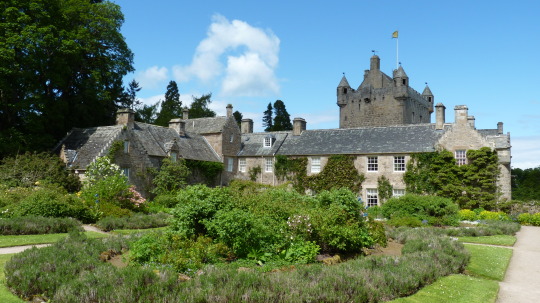
Today's Flickr photo with the most hits: Castle Cawdor, from the gardens.
1 note
·
View note
Text

It is said that every turret in Fyvie Castle holds a secret..
#Fyvie Castle#Aberdeenshire#Scottish castles#UK#River Dee#Scottish Highlands#turrets#baronial architecture#rural britain
22 notes
·
View notes
Text
THIS DAY IN GAY HISTORY
based on: The White Crane Institute's 'Gay Wisdom', Gay Birthdays, Gay For Today, Famous GLBT, glbt-Gay Encylopedia, Today in Gay History, Wikipedia, and more … April 25
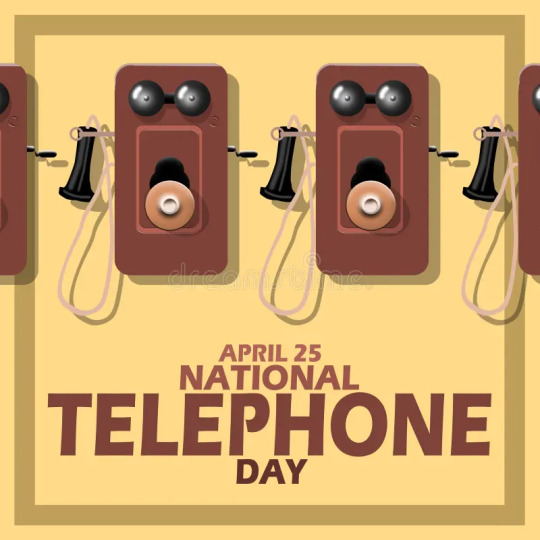

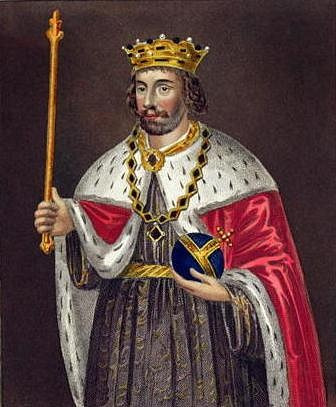
1284 – King Edward II of England was born on this date (d.1327). Unlike his warrior father, Edward had little interest in fighting battles himself. His pursuits were not those typically approved of in kings at this time. Edward preferred such activities as swimming, boating, thatching roofs, and arranging theatrical and musical events.
Edward also gambled, frequently losing large sums of money. In addition, he formed intense friendships with men whom his father felt wielded too much influence over the prince. Piers Gaveston, a knight from Gascon, was the first and most important of Edward's favorites.
Gaveston and Edward may have become intimate friends during the Scottish campaign led by Edward I in 1300. The king became critical of this friendship, and exiled Gaveston from England.
In 1307 Edward I died, and Edward II became King of England. He immediately called Gaveston back from exile, despite the opposition of most of the English barony, who disapproved of the new king's close relationship with his favorite.
In 1308, leaving gaveston as Regent, Edward travelled to France to marry Isabella, the daughter of King Philip IV of France, in an attempt to bolster an alliance with France. On 25 February the pair were crowned in Westminster Abbey. The marriage, however, was doomed to failure almost from the beginning.
The nobles' increasing dissatisfaction with Edward led them to use Gaveston as a way to gain power over the king. In 1311, Thomas, Earl of Lancaster, led the barons to demand a number of political reforms, as well as the exile of Gaveston. Edward bridled at the restrictions, and Lancaster's faction rebelled.
Edward and Gaveston were ill-prepared for the rebellion, and after being besieged in his castle, Gaveston quickly surrendered, assuming he would be treated favorably by the Earl of Pembroke. The Earl of Warwick subsequently captured Gaveston and after a bitter exchange, he was tried and convicted of treason, handed over to Lancaster, and summarily executed.
Gregory Bredbeck argues that the idea of Edward's homosexuality is "almost entirely an invention" of the late Renaissance. He credits Christopher Marlowe's play The Tragedy of Edward II (1590?) as largely responsible for his inclusion in gay and lesbian history.
Edward's love for Gaveston certainly defied conventional boundaries, but it is hard to pinpoint whether Edward's ultimate transgression was simply loving one man too much, thereby unsettling the delicate balance of patronage, or was a violation of sexual boundaries as well.
Several of the contemporary chroniclers, while not saying specifically that the relationship between Edward and Gaveston was sexual, certainly describe it in sexual terms, one saying that the king fell in love with the young noble "at first sight." Moreover, as Alan Bray points out, one royal document characterizes the union between the two men as a kind of "wedded" or "sworn" brotherhood, a form of voluntary kinship.
We can not say with certainty that Edward practiced same-sex sexual activity with Piers Gaveston. We do know, however, that later in his reign, Edward formed an equally intense relationship with Hugh Despenser.
Unlike Gaveston, who had little interest in wielding political power, Despenser used his influence to gain power for himself and his father. In 1322, Edward defied renewed attempts by the nobles to restrict his power and allowed Despenser and his father to rule the country.
In 1326, Isabella, who had been estranged from Edward since 1322, and Roger Mortimer, a baron who had become the queen's lover the year before, invaded England and captured Edward and the Despensers.
They quickly tried, convicted, and executed Hugh and his father. They officially removed Edward from the throne and imprisoned him. His son became king, while Edward languished in prison. After being tortured, he was killed on September 21, 1327.
According to contemporary chonicles, Edward was killed by having a red hot spit thrust into his anus. While this method of execution may have been chosen to conceal signs of torture, the fact that it symbolically suggests homosexual intercourse was not lost on later poets and playwrights who told the story of the king's tragic life and death.


1915 – Thomas Savage (d.2003) was an American author of novels published between 1944 and 1988. He is best known for his Western novels, which drew on early experiences in the American West.
Savage was born in Salt Lake City in 1915 to Elizabeth and Benjamin Savage. His parents divorced when he was two years old, and he moved with his mother to a ranch near Lemhi, Idaho. When his mother remarried Charles Brenner in 1920, Savage moved with his mother and his stepfather to the Brenner cattle ranch in Beaverhead County, Montana. Charles Brenner adopted young Savage, who took the Brenner name. However, Savage felt like a misfit on the ranch. Savage was home schooled in the early grades but the Brenners sent him away to Dillon, the nearest town of any size, to attend high school. Savage's early experiences influenced his writing and are reflected in many of his novels.
In 1932, Savage graduated from Beaverhead County High School. Savage studied writing at Montana State College (today the University of Montana), where he met Elizabeth Fitzgerald, who then left to study English Literature at Colby College in Waterville Maine. Savage published his first story, "The Bronc Stomper", in Coronet in 1937, to some critical success, and then joined Elizabeth at Colby. He and Elizabeth were married on September 15, 1939; theirs was the first marriage of two Colby students.
After their marriage, the Savages lived briefly in Chicago before moving back to Montana in 1942 to work on the Brenner ranch. World War II made it hard to find ranch hands, and Charles Brenner needed help.
By the time Savage was 29, he had worked as a wrangler, ranch hand, welder, and railroad brakeman.In 1944, Doubleday published Savage's first novel, The Pass. In spite of encouraging sales, revenue from the book was not enough to support the Savage family, which now included two boys, Robert and Russell.
In 1949, he began teaching at Brandeis University in Waltham, Massachusetts, founded just a year earlier. He was promoted to assistant professor in his third year. In 1953, he published his third book, A Bargain with God, his most popular success, confirmed when republished in a condensed version by Reader's Digest. By 1955, Savage was able to leave Brandeis and devote himself to writing full-time.
In 1982, the Savages built a home on Whidbey Island in Puget Sound, on property given to him by his sister. Savage published the last of his 13 novels in 1988. Set in Montana, The Corner of Rife and Pacific follows the founders of a tiny Montana town over several generations. Elizabeth died on Whidbey Island in 1989. Savage kept a photo of her by his bedside until his death. He observed that any loving partnership required laughter and good conversation, and after her death he often complained that he missed her conversation.While married, Savage had several long-term and close relationships with men, only after he began slowly coming out in the late 1950s. His wife was aware of his homosexuality before they married. Late in life, he told his daughter he should not be characterized as bisexual. Manohla Dargis, in her New York Times review of the 2021 film based on Savage's The Power of the Dog, described him as "a closeted gay man".


1918 – Graham Payn (d.2005) was a South African-born English actor and singer, also known for being the life partner of the playwright Noël Coward. Beginning as a boy soprano, Payn later made a career as a singer and actor in the works of Coward and others.
He made his first stage appearance, aged 13, at the London Palladium, as Curly in Peter Pan. At the age of 14, he auditioned for the Noël Coward and Charles B. Cochran revue Words and Music (1932). His audition piece, singing "Nearer My God to Thee" while executing a tap dance, was so striking that Payn won two tiny parts in the revue. For 163 performances, he played a busker entertaining a cinema queue as a lead-in to the ballad "Mad About the Boy", and announced, in top hat, white jacket and shorts, the show's other hit song "Mad Dogs and Englishmen".
At the outbreak of World War II, when all the theatres were closed, Payn volunteered for the army but was discharged on health grounds because of a hernia after a few weeks.
In 1942, he appeared in a revue, Fine and Dandy,where he sang Coward's "London Pride". One night, Coward came backstage after the performance. Payn later wrote, "I remember being very nervous, not having seen him for the best part of 10 years, though I was pleased as punch to be recognised in my own right." Coward's verdict was, "Very good. Splendid." In 1943, Payn announced his engagement to marry Sheila Ascoli, but the wedding did not take place.
In the Leslie Henson show Gaieties (1945) Payn sang and danced "White Tie and Tails". Coward came backstage after a performance and offered Payn a leading part in his forthcoming show, Sigh No More, which, Payn wrote in his memoirs, "marked the beginning of a personal and professional relationship between Noël and myself that would last until his death."
Coward continually promoted Payn's career. He was widely thought to overrate his protégé's talents. Payn received consistently good notices for his performances, but lacked drive and star quality, as he himself knew. Coward also eventually came to realise it, writing:
"He is, I fear, a born drifter. I know his theatrical career has been a failure but there are other ploys to go after. He sleeps and sleeps, and the days go by. I love him dearly and for ever, but this lack of drive in any direction is a bad augury for the future. I am willing and happy to look after him for the rest of my life, but he must do something."
Payn also did some film work. In 1949 he was in the Borstal drama Boys in Brown, with Dirk Bogarde and Richard Attenborough. He appeared in two films with Coward: The Astonished Heart (1950) and The Italian Job (1968), in which Coward played a criminal mastermind with Payn as his obsequious assistant.
After Coward died in 1973, Payn's career became the administration of the Coward Estate. The Coward authority Barry Day wrote,
"It was not a job he ever wanted or expected but he brought to it a dedication and focus that Noël would have been surprised and pleased to see. [He] was thrust into his biggest role and played it as he knew Noël would have wanted him to. It was a fitting farewell performance."
Coward's biographer, Philip Hoare, wrote,
"Graham disproved his partner's assessment of himself as 'an illiterate little sod' by publishing his memoir and by managing the Coward estate. He was a generous, uncomplicated man, and he will be missed by his many friends."
Payn wrote Noël Coward and His Friends (1979) with Sheridan Morley and Cole Lesley, and, with Morley, was co-editor of The Noël Coward Diaries, which they dedicated to Lesley. Payn wrote his autobiography, My Life With Noël Coward, in 1994.

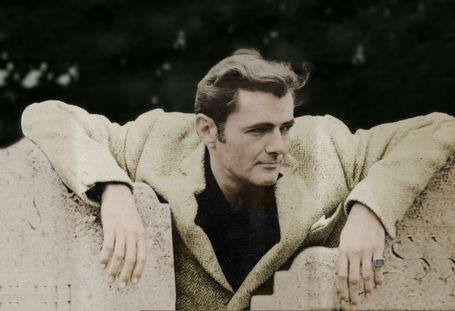
1923 – David Derek Stacton (born Arthur Lionel Kingsley Evans) was an American novelist, historian and poet (d.1968).
Stacton was born in San Francisco. In author profiles, however, he claimed to have been born April 25, 1925 in Minden, Nevada (several of his books are set in Nevada). Stacton attended Stanford University from 1941–43. He served in the Civilian Public Service as a conscientious objector. He legally changed his name to David Derek Stacton on September 3, 1946 to disassociate himself from his father, and because he believed the surname was unique to him. He attended San Francisco State College from 1947–48, and graduated from the University of California, Berkeley in January 1951. He lived in Europe from 1951–1954, 1960–1962, and 1964–1965. Most of his books as David Stacton were originally published in England. Stacton wrote under the pseudonyms Carse Boyd, Bud Clifton, David Dereksen and David West. He also ghosted Living Religions Of The World a 1956 work accredited to Frederic Spiegelberg.
Stacton may have lied about being married, and recollections by friends and people who personally met him strongly indicate that he was gay and unafraid of being flamboyant in person. One memoir records Stacton's penchant for drag. The few author descriptions in contemporary reviews were much taken by his wearing of cowboy boots. In 1965-1966 he taught at Washington and Lee College.
David Stacton's earliest published works were poems, often betraying the influence of T.S. Eliot, which were published in American little magazines. They were collected in 1953. David Stacton began as a writer of moody California-based novels, became moderately well known as a writer of short, concentrated historical and biographical novels, and then ended his career as a writer of lengthy histories. His historical novels are distinctive for covering many disparate periods and historical figures and were popular with a coterie of critics but they never reached a wide audience.
Several of Stacton's novels feature homosexual characters prominently when this was uncommon.

Besides the novels and other literary works published under his name, he also published a wide range of pseudonymous cowboys, thrillers and exploitation novels. Pulp novels about juvenile delinquents written under pseudonyms proved very popular, were translated into numerous languages and D for Delinquent was one of Ace’s top sellers for 1958. The Power Gods, about a motorcycle gang, was set in Nevada. Muscle Boy features in many histories of gay pulp fiction. Muscle Boy was inspired by an actual crime ring based in San Francisco, but Clifton transplanted the action to Muscle Beach and populated it with an assortment of flamboyant party boys and hustlers. The reaction of the real life figures identifiable in the novel was one reason he left the San Francisco area, more or less permanently, in 1959.
He died January 19, 1968 in Fredensborg, Denmark. His death was reported as being from a stroke. Stacton had suffered from epilepsy since a child.

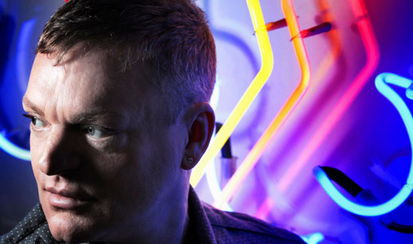
1964 – (Andrew Ivan) Andy Bell the lead singer of the English Synthpop duo Erasure was born today. Originally working in a meat packing plant in the UK, Bell responded to a newspaper advert that was looking for a singer. The 43rd auditionee responding to the ad, he was picked by Vince Clarke and together they formed the group Erasure. The pair have sold over twenty million albums worldwide.
Apart from his work with Erasure, he has taken part in numerous charities including the Ferry Aid version of "Let It Be" in 1987, a cover of Cole Porter's "Too Darn Hot" that was included in 1990s Red Hot + Blue album to raise funds for AIDS and HIV research, re-making Lene Lovich's "Rage" alongside her to be included in PETA's album in 1991 in favour of a wildlife campaign and performing twice on Big Spender's Red Hot and Dance events to support various AIDS projects (in December 1994 and November 2004). Bell also performed on the True Colors Tour 2008. Bell sang the role of Montresor in Peter Hammill's opera The Fall of the House of Usher, released in 1991 and reissued with a new recording in 1999.
He is openly gay and was a longtime partner of Paul J. Hickey. On 17 December 2004, he publicly announced that he is HIV-positive and has been aware of this since 1998. Bell told Melody Maker in 1986,
"I don't want to go out of my way to talk about it but I'm not going to pretend I'm not [gay]. I won't portray a heterosexual in videos and we're consciously doing lyrics that could apply to either sex".
He told Barry Walters of Seventeen,
"I want to be known as a good performer but it's important for me to take a stance. If you're doing music you use it for something and have substance being gay and open about it."
In a 2007 interview, Bell remarked that a complacency exists among gay men about HIV, specifying that:
There are definitely HIV-positive people who meet other HIV-positive men, and like still having unprotected sex. I think it must be quite hard for young gay men because there is so much for them now to do - there are so many saunas and stuff like that for them to go to, and it's so easy to get it."
He has also practised reiki since the early 2000s. He has suffered from avascular necrosis (which has no relationship to his HIV diagnosis) and has had both hips replaced. Bell has stated that this keeps him from "pogoing around" compared to previous performances.
July 2005 brought the announcement of Bell's first solo album. He signed a worldwide solo recording deal with Sanctuary Records and announced details of his debut album, which was released on October 3, 2005, and entitled Electric Blue. The album features fourteen tracks, including three duets, with Claudia Bracken of Propaganda and Jake Shears of Scissor Sisters, and encompasses a variety of musical genres.


1971 – Jose Roberto Pulido Jr., known professionally as Bobby Pulido, is an American singer, songwriter, guitarist, and actor. He is credited for introducing Tejano music to a youthful crowd and became a teen idol and one of the most influential Tejano recording artists among Mexican American teenagers.
Pulido debuted on the music scene in 1995 as the lead vocalist of his eponymous band. That same year he signed a recording contract with EMI Latin and released his debut album, Desvelado. The album peaked at number nine on the United States Billboard Top Latin Albums chart and at number three on the U.S. Billboard Regional Mexican Albums chart. The title track of Desvelado launched Pulido as a popular Tejano musician, but he was criticized by veteran musicians, who believed he was successful in the genre because of his father Roberto Pulido's established music career.
In 2003, Pulido made his acting debut by starring in the made-for-television film La Decada Furiosa. He also appeared in the telenovelas Fuego en La Sangre and Qué pobres tan ricos.
Pulido married Eliza Anzaldua in July 1996. They had three sons. However, Pulido filed for divorce in September 2013, after 17 years of being married and four months of separation. He currently resides in Miami, Florida and enjoys working out, eating healthily, and playing golf; his favorite pastime is playing guitar and he finds composing songs therapeutic.
During his musical career, Pulido's fans questioned his sexuality; he said he is not homosexual but rumors that he had slept with men continue to circulate. Pulido spoke to a Mexican television news program in 2013, and told viewers he is heterosexual and that he has gay fans, which he said did not concern him. In April 2010, media outlets questioned Pulido after he released a music video in which he plays a stereotypical gay male; the singer said he wanted to "try something different [in his music videos]" and defended his gay followers, saying he nothing against the LGBT community. After American Latin pop singer Ricky Martin publicly announced his homosexuality, Pulido defended Martin's choice, saying "he is living his dreams".
Pulido has been an outspoken opponent of the 2016 U.S. presidential candidate and Republican presumptive nominee Donald Trump. On his Instagram account, Pulido uploaded a picture of himself "urinating" on Trump's star on the Hollywood Walk of Fame.


1988 – Jonathan Bailey, born in Oxfordshire, England, is a British actor in theater and television. He is best known for roles on the television series Broadchurch and Crashing. He is openly gay and is involved with the Albert Kennedy Trust for LGBT young people who are homeless or in negative circumstances.
Bailey decided he wanted to act when he was watching a Christmas play of Oliver! with his grandmother. a Through the dance school of one of his sisters, he got an agent who put him through an audition at the Royal Shakespeare Company. He acted the first time in 1995 at a performance of A Christmas Carol as Tiny Tim in the Barbican Theater on stage. Next came the role of Gavroche in the musical Les Misérables.
He did not go to a theater school or university, but began rehearsing for a production of Beautiful Thing in 2006 right after his school leaving exams.
In 2018, Bailey starred in a homosexual relationship in the early 60s in a 2001 re-production of Peter Gill's The York Realist at Donmar Warehouse . In preparation he read Alan Down's The Velvet Rage and attended the Queer British Art Exhibition at Tate Britain . He said, "I want to find stories that humanize homosexual experiences and Peter Gill does it well."
In a 2018 and 2019 Gielgud Theater revival by Stephen Sondheim's Company starring, Bailey played the original female role Amy as Jamie in a swapped cast, so that in this variant a homosexual couple was shown. He said, “You literally don't have to change a single word and suddenly you have a very honest, glowing portrayal of a man stepping on the spot between queer culture and the heteronormative ideal of marriage. This contradiction and the debate are so relevant right now.” He won the Laurence Olivier Award for Best Actor in a Supporting Musical Role for Jamie.
For the Albert Kennedy Trust, Bailey arranged a fundraising gala with Chief Exec Tim Sigsworth in the Donmar Warehouse in 2018 and hosted one with the rest of the Company's cast in 2019 .
Bailey was best known for a supporting role in the first two seasons of Broadchurch in 2013 and 2015 as newspaper reporter Olly Stevens, a leading role in W1A from 2014 to 2017 and in 2016 in Crashing as Sam, who discovered his homosexual feelings for a house roommate.In 2020 he will appear in the series Bridgerton, a film adaptation of the book series of the same name by Julia Quinn.


1993 – The Third March on Washington has an estimated attendance one million people.

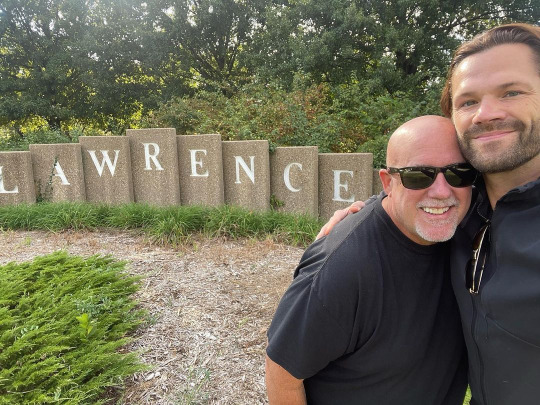
1995 – Lawrence, Kansas passes an ordinance prohibiting discrimination based on sexual orientation. The law, the culmination of a 7-year struggle, is the only one of its type in the state of Kansas.


12 notes
·
View notes